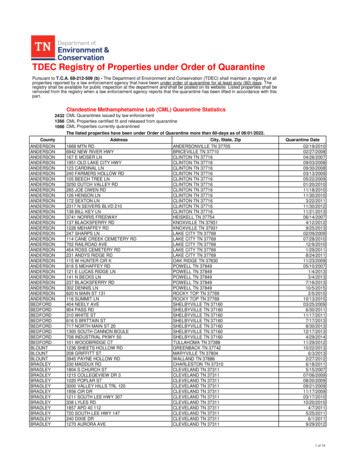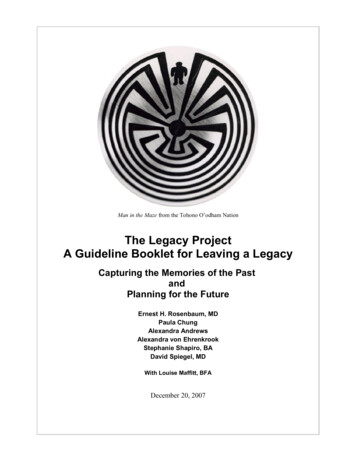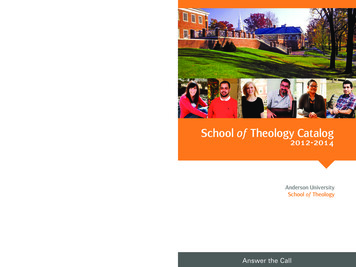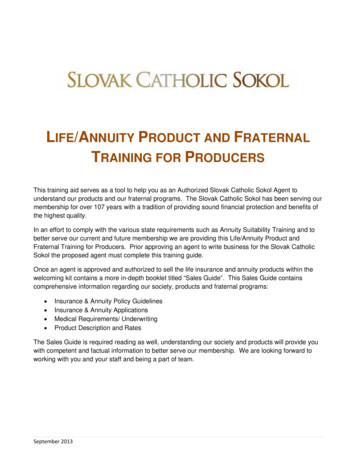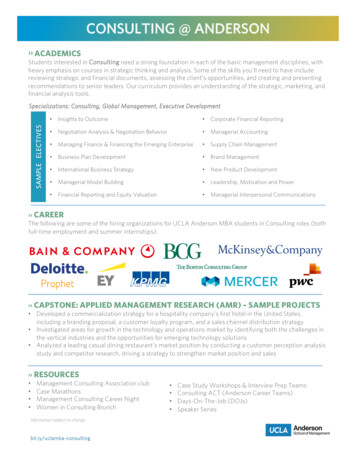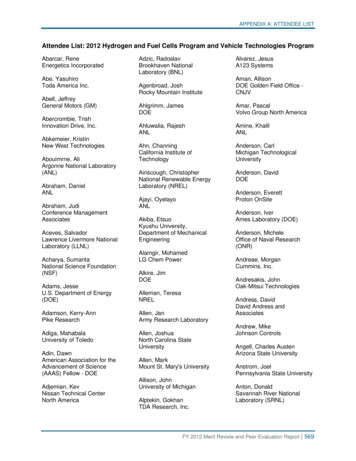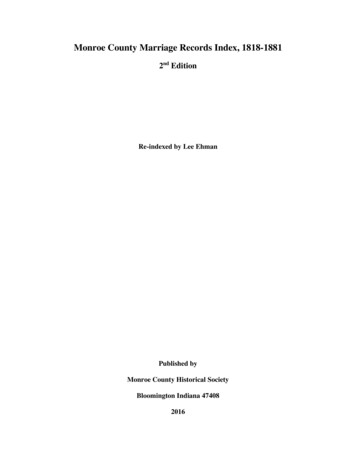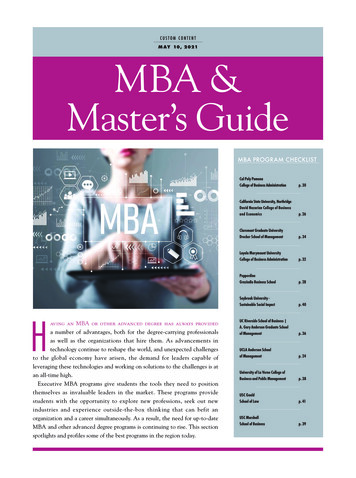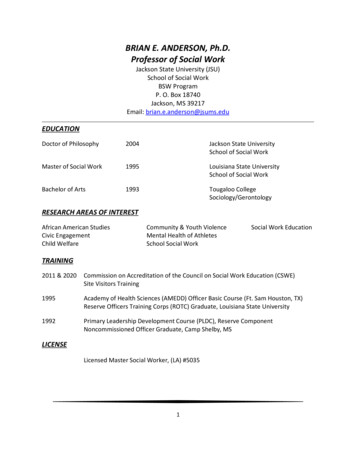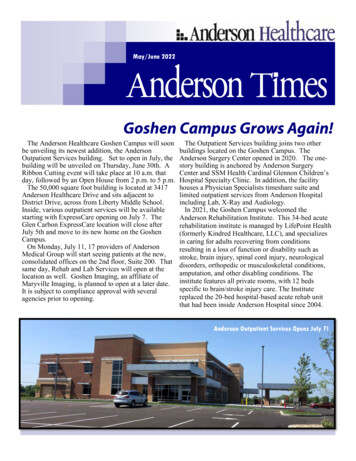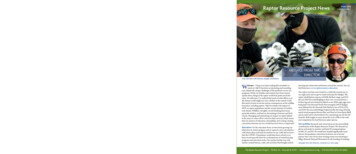
Transcription
LEAVING A LEGACY ROBERT ANDERSONMEMORIALSCHOLARSHIPRaptor Resource ProjectPO Box 16Decorah, IA 52101NONPROFIT ORG.U.S. POSTAGERaptor Resource Project NewsPAIDTWIN CITIES, MNPERMIT NO. 2805Winter 2020Volume 4 Number 1Raptor Resource ProjectJohn Howe – Executive DirectorAmy RiesBoard of DirectorsJohn Dingley (President)Laura Johnson (Vice President)David Lynch (Treasurer)Dave KesterBrett MandernackNeil RettigJim RobisonJeff WorrellWe are proud and honored to receive significant bequests along with manyother individual gifts. Many devoted Decorah Eagles followers express intheir own special way what a difference being able to watch “their eagles” has madein their lives. Whether it be a family or personal request to donate to RRP or a formalbequest, these thoughtful gifts have a profound impact on how we deliver on ourmission. We are very thankful for donations to help us carry out what we do. What isa bequest? It is the act of giving or leaving somethingby will. A synonym is—Legacy. We are honored toshare a little bit of information about two DecorahEagle followers who wanted to make a difference:Judith Batinchok, also known as GigglePup,was an avid Eagles watcher. She would watch dailyas the eagles brought great joy to her daily routine,especially during her last few years. This donation(her bequest) was her way of saying “Thank You” forproviding service to all the present and future eaglewatchers out there. You can see from the attachedphoto and the smile on her face, that she was a proudmember of the “Cottonwood Club”!Janice Bosworth was an RRP Decorah Eagles Moderator and loved the eagles.Jan loved her role as a volunteer, working with her fellow Mods, and especially thechatters. She got along with everyone and was always greeted with love from thechatters. Her commitment was unwavering, and she is missed!We are very honored that Judith and Janice chose to support the Raptor ResourceProject in this way. We know from so many letters and accounts from DecorahEagle followers that the excitement and joy of watching them raise their young andjust “be eagles” is a motivational factor to get up every day. It is humbling to knowthat bringing the Decorah Eagles and our other raptors to the public can have sucha lasting impact on people’s lives, friendships, and families. If you are interested inleaving a lasting legacy, contact our planned giving representative and Board memberJeff Worrell (phone: 651-212-3026; email: jeffw@raptorresource.org).Bob at Minnesota Power’s Clay BoswellPlant.We have awarded scholarships— 1,500 each—to two Luthercollege students in the EnvironmentalStudies program. Our first scholarshiprecipient was awarded to Sean McKenziein 2019. Our second recipient for 2020is Piper Wood. It is exciting to see oursecond scholarship awarded with theknowledge that the fund balance isgrowing and in great shape with yourgenerous contributions!The Robert Anderson MemorialScholarship Fund was created tohonor Bob’s passion for raptors andto support local students on theirway to environmental conservationcareers. The Raptor Resource Projecthas partnered with the WinneshiekCounty Community Foundation andLuther College to deliver scholarshipsto selected Luther College students.Gifts are received through contributions,bequests, charitable trust remainders,and other gifts directed to the Fund.Students will be selected on criteriaincluding demonstrated concern forthe environment through positiveenvironmental activism and communityinvolvement or independent studiesrelated to environmentalism. Donationsare welcome! To make donations tothe fund, contact the CommunityFoundation of Northeast Iowa at 319287-9106 or go to: ial MediaLive Cam ModeratorsCam OperatorsRaptor SurveyorsVideographers & PhotographersMESSAGE FROM THEDIRECTORThis newsletter was made possible by a generous grant from explore.org – Thank You!We would like to thank our many partners Landownersexplore.orgXcel EnergyDairyland PowerMinnesota PowerGreat River EnergyRed Wing GrainArdent MillingLuther CollegeWinneshiek CountyCommunity FoundationUS BankBrice Prairie ConservationAssociationSHOP OUR MERCHANDISEShow your love for the Decorah Eagles, DecorahNorth Eagles, Mississippi Flyway, and Great SpiritBluff—with our new mugs and Christmas ornamentsat: www.zazzle.com/store/rrp gifts and more or goto our website and click ‘Shop’ at top right, next toDonate and Subscribe. In addition to RRP-createdproducts, a fan, Sunset Dreamer, created beautifulmugs, ornaments, and notecards. All proceeds goto benefit the Raptor Resource Project. We alsoplan to have Decorah, Decorah North, and Flywaycalendars available by November 23. Watch ourwebsite and Facebook page for more details!La Crosse District - Upper MississippiRiver NW&FRCornell Lab of Ornithology and Donors like You!Amy and John with falcons, Maggie and Robert.Welcome – I hope you enjoy reading this newsletter asmuch as I did! It has been an interesting and rewardingyear, despite the unique challenges of the pandemic across ourprograms. While our families and routines have been turnedupside down, things in the raptor world look pretty much thesame. On reflection, I’ve realized that much of what affects us inthe human world might not raise a feather in the natural world.But much of what we do has serious consequences on the wildlifearound us, including raptors. Take for instance the impact ofDDT on raptor populations and the recent extremes of weatherand climate. Wildfires, droughts, record-breaking hurricanes,pesticide residues, and lead are devastating to humans and birdsof prey. Managing and minimizing our impact on raptor habitatin the years to come will be critical to their survival, which meansthat our mission of education, stewardship, and creating a lastingconnection between our two worlds has never been so important!Education: On the education front, we have been growing ourEducation In Action program and we opened a new web interfacewith lesson plans and tools for teachers to use. Little did we knowthat the COVID-19 pandemic would shut down school as weknow it and open the door for accelerated use of virtual learningprograms and education tools. Our teachers led the way withteacher-created lessons, crafts, and activities that brought remotewww.raptorresource.orgJohn HoweRRP Directorlearning into classrooms and homes around the country. You canfind them here: www.raptorresource.educationOur raptor cam fans were treated to a relatively normal year atour eagle nests and we got to watch and enjoy five fledges. Theraptor rehabilitation experts at SOAR did their magic and D32,the last 2019 Decorah fledgling in their care, recovered from abroken leg and was released in March as our 2020 eagle eggs werebeing laid! Our Decorah North Nest youngster DN12 fledgednext, followed by the Decorah Fish Hatchery trio of D34, D35,and D36! The successful fledges helped soothe the sting of losingmuch-loved peregrine falcons Elise and Floyd at Great Spirit Bluffand an early end to what looked to be a promising year for the WIKestrels. Both taught us more about the circle of life in the wildand competition for food between raptor species.Stewardship: Research and conservation are key stewardshipcontributions of the Raptor Resource Project. We donned ourgloves and masks to monitor and band 50 young peregrinesin MN, IA, and WI. We would have banded significantly morefalcons, but pandemic restrictions locked us out of severalpartner sites. One of our most exciting events was returning toEffigy Mounds National Monument for the banding of nestlingsMessage from the Director, continued on next page The Raptor Resource Project PO Box 16 Decorah IA 52101 www.raptorresource.org 276-FALCON2 (276-325-2662)
Message from the Director, continued 21 years after the RaptorResource Project completeda historic two-year releaseof cliff-hacked falcons.Our project successfullyreintroduced the post-DDTpopulation of peregrinefalcons to the historiccliff eyries they calledhome along the mightyMississippi River. It was ajoyous occasion with RRPBoard members and crewattending, including JohnDingley and Dave Kesterwho were critical in helpingRRP founder Bob Andersonwith the hard field work thatresulted in the program’ssuccess.John Howe banding falcon, Robert.TEACHER’SCORNER Lori Carnes –2nd Grade TeacherEDUCATION UPDATEThe Raptor Resource ProjectLori Carnescontinues to expand educationalresources available to teachers and the public. An RRP sisterwebsite, www.raptorresource.education, was launched toprovide environmentally-based, educator-created remote learningmaterials for students of all ages. Our teacher created lessons, crafts,and activities bring remote learning with Bald Eagles, PeregrineFalcons, and the Mississippi River Driftless Area into classroomsand homes. Educators—including homeschoolers—can build onIt is hard to describe just how many people were involved inthe events that led up to banding at Fire Point. Brett and CaroleMandernack worked with Bob to produce young falcons incaptivity back in the mid-1980s. Bob engineered a plan foraddressing nest-site imprinting with the help of our late Boardpresident Rob MacIntyre and current Board president JohnDingley. After Bob moved to Iowa, Dave Kester and John Dingleyhelped him build the special eyrie and hack the falcons. PatSchlarbaum got the Iowa DNR involved in returning the PeregrineFalcon to Iowa’s skies and provided a lot of hands-on help. The staffof Effigy Mounds supported this work and provided a place for it tohappen.Engagement: Our future leaders in raptor conservation standamong us today. Each class of young students that is introducedto life in an eagle nest or the beauty of a buteo moves us along inour goal of engaging and developing our future conservationists.It is so promising and exciting to watch and experience studentslearning through raptors in the classroom or in the banding blind.Whether it is watching the Decorah Eagles or holding and releasinga hawk, there is nothing more engaging or effective in developinga connection and love for nature. I’m proud of the success of ourteachers, volunteers, and conservation partners. Thank you forsupporting our programs, your interest, and your contribution toour future.PARTNER SPOTLIGHT:Great River EnergyPROGRAM SPOTLIGHT:Camera InstallationWhen Great River Energy decidedin September 2019 to closeElk River, Brenda Geisler, a 20-yearGreat River Energy employee andresident raptor expert, immediatelystarted work on relocating the internetfamous nesting site. “A lot of co-opsare experiencing plant retirements and alot have peregrine nests,” she says. “I’mhopeful moving this nest is a way to keepBrenda Geisler with this a legacy for this plant and others.”a banded falcon.John working on a camera.Kike and Neil before climb.Tlesson plans or share our interactive lessons and apps with theirstudents via Google Classroom. We have 35 lessons right now,including 11 Google Classroom-ready lessons, and are continuingto add more.I have been asked how I found the time to teach about baldeagles. I didn’t teach eagles, I taught my curriculum using eagles.When I covered collective nouns, we talked about the examplesI used in the lesson plan and learned about a communal roost, aconvocation, and a kettle. The students added these vocabularywords to their eagle journals, along with a definition and sketchcreated by each student and a label for each part of speech (noun,verb, adjective). I also used the eagles to teach different typesof writing. There were no reluctant writers when my studentswatched a video and formed their opinions about what theythought the eagles were thinking and doing! Using a high-interesttopic like bald eagles leads to greater in-depth learning.he Raptor Resource Project performs eagle caminstallation, cleaning, and maintenance each year inSeptember. This fall in Decorah, we replaced three camerasand two microphones at N2B and two cameras and onemicrophone at N1. At the North Nest, we installed one cameraand two microphones. We also cleaned cameras camera lenseswe didn’t replace, did some branch trimming in and aroundthe nests, covered the camera cables in the area of the oldnest at N1, worked with a videographer to collect footage foreducational videos, and purchased a new computer for 4Knest cam video processing in Decorah. Why do we chooseSeptember for camera work? Our eagle couples are still onterritory, but they aren’t focused on their nests or young andtravel away from the nest. That means we can work around thenest areas without disturbing them and driving them away.September affords us a narrow window to get everything done.Replacing cameras requires at least a three-person team andmonths of preparation and planning. We research, purchaseand program equipment, protect what feels like miles ofcable, and purchase or assemble everything we think mightbe needed: tubing, conduit, electrical tape, paint, clamps, zipties, silicone gel, screws, bits, hardware cloth, networking toolsand supplies, carabiners, webbing, ropes, rope guns and so on.The list is easily as long as your arm and everything needs tobe organized, sorted, and hauled down to command centralbefore camera work starts. This year was special in that wealso were challenged with lodging, dining, and working inclose proximity during the pandemic! We implemented ourCOVID-19 protection plan while we completed our work.Kike and Amy installing cameras.Once we’ve got our ropes placed up in the nest tree—a sagain and of itself—the long days start. We climb up and downropes, fix gear, haul up cameras, and troubleshoot problems aswe go. How do we protect microphones from squirrels? Whatbranches provide the best views of the nest? How do we installcameras with minimal impact to the eagles and their nest tree?How much wind is too much to work in? Are we descending toeat lunch or hauling lunch upstairs? How do we get this cabledown the tree and secured? Why did this camera stop working?How does this camera angle look? A thousand questions anddemands inform each day’s work, and each day brings newchallenges. We have about three weeks to get everything right.To find the right accommodations intime for the birds’ early 2020 return, Geisler assembled a24-member team. After several meetings, the team decided tomount the nest box atop a 90-foot power pole stabilized byguywires. “Peregrine falcons prefer to nest hundreds of feetabove the ground and near a reliable food source,” says JohnHowe, Executive Director of the Raptor Resource Project inDecorah, Iowa, and one of the wildlife specialists on the team.“Other than the turbine building [at Elk River Station], thehighest facility structures at the site were only a couple storieshigh with employee traffic coming and going almost daily.“Then Brenda shared an idea she had of using a large utilitypole. We thought that just might work, since it was close by anda familiar area in the vicinity of their original nest box.”Geisler designed a spacious box with perches outside everycorner. Lightning protection was added to the pole, and a3-foot wide sheet of metal was wrapped around its base toguard against racoon invasions. On January 30, three linemenraised the pole topped by the new nest box on a slope above aWhat do Mom and Dad or Mr. North and DNF think about allof this? We can’t ask them, but we can say that they don’t appearto be bothered by it. Mom made a couple of distant fly-byswhile we were working, but we didn’t see the North eagles nearthe nest at all and both pairs of eagles returned to their nestsshortly after our work was done. Careful timing and months ofpreparation ensure that we can complete our work before nestbuilding begins—typically in October.In 2011, the Decorah Eagles kicked off a wildlife camrevolution that continues today. What started as an off-thecuff offshoot of a film project (wouldn’t it be fun if we put thisonline?) resulted in new, less invasive research methods andmillions of people around the world watching wildlife theywouldn’t have been able to see otherwise. Thank you so muchfor supporting our eagles and the work we do to bring them—and many other species—to you!www.raptorresource.orgGreat River Energypollinator gardenof native flowers,grasses, and foliage.Down the hill isInterstate 10 and theMississippi River,which the falconsuse as a highway totravel south for thewinter and back inspring.Would peregrinesadopt their newNewly re-located nest boxhome? On March 3,on pole.the team got theiranswer when Breezyand Brooklyn, afamiliar falcon couple, appeared along the river. The sharp-eyedraptors spied the new nesting box high on a pole next to thenow nearly demolished power plant. “I was wondering if theywere going to accept the new nesting box and location, if itwas going to be good enough,” Geisler says. “I felt a lot of reliefwhen I saw them lay their first eggs.”Great River Energy’s team had achieved a rare accomplishmentin falcon conservation.“We have successfully relocated peregrine falcon nest boxesbefore, but not using a free-standing pole,” says Amy Ries,who manages the peregrine falcon monitoring program for theRaptor Resource Project. “Great River Energy’s project was thefirst pole-mounted nest box relocation we are aware of,and we were very excited when Breezy and Brooklynadopted it—and even more excited when they raisedfour healthy young this spring.”“This project is significant, because it shows thatperegrine falcons will occupy and nest in artificialnest box towers in the absence of natural cliffs or tallbuildings,” Howe says. “The GRE Elk River facility hasbeen a productive falcon nest site, and with the care andingenuity of Brenda and the Great River Energy team, itwill be for years to come.”Breezy with her young.This story was written by Cathy Cash for the NationalRural Electric Cooperative Association and is republished by permission: www.electric.coop.It ran in the December 2020 issue of RE ult.aspx.www.raptorresource.org
Message from the Director, continued 21 years after the RaptorResource Project completeda historic two-year releaseof cliff-hacked falcons.Our project successfullyreintroduced the post-DDTpopulation of peregrinefalcons to the historiccliff eyries they calledhome along the mightyMississippi River. It was ajoyous occasion with RRPBoard members and crewattending, including JohnDingley and Dave Kesterwho were critical in helpingRRP founder Bob Andersonwith the hard field work thatresulted in the program’ssuccess.John Howe banding falcon, Robert.TEACHER’SCORNER Lori Carnes –2nd Grade TeacherEDUCATION UPDATEThe Raptor Resource ProjectLori Carnescontinues to expand educationalresources available to teachers and the public. An RRP sisterwebsite, www.raptorresource.education, was launched toprovide environmentally-based, educator-created remote learningmaterials for students of all ages. Our teacher created lessons, crafts,and activities bring remote learning with Bald Eagles, PeregrineFalcons, and the Mississippi River Driftless Area into classroomsand homes. Educators—including homeschoolers—can build onIt is hard to describe just how many people were involved inthe events that led up to banding at Fire Point. Brett and CaroleMandernack worked with Bob to produce young falcons incaptivity back in the mid-1980s. Bob engineered a plan foraddressing nest-site imprinting with the help of our late Boardpresident Rob MacIntyre and current Board president JohnDingley. After Bob moved to Iowa, Dave Kester and John Dingleyhelped him build the special eyrie and hack the falcons. PatSchlarbaum got the Iowa DNR involved in returning the PeregrineFalcon to Iowa’s skies and provided a lot of hands-on help. The staffof Effigy Mounds supported this work and provided a place for it tohappen.Engagement: Our future leaders in raptor conservation standamong us today. Each class of young students that is introducedto life in an eagle nest or the beauty of a buteo moves us along inour goal of engaging and developing our future conservationists.It is so promising and exciting to watch and experience studentslearning through raptors in the classroom or in the banding blind.Whether it is watching the Decorah Eagles or holding and releasinga hawk, there is nothing more engaging or effective in developinga connection and love for nature. I’m proud of the success of ourteachers, volunteers, and conservation partners. Thank you forsupporting our programs, your interest, and your contribution toour future.PARTNER SPOTLIGHT:Great River EnergyPROGRAM SPOTLIGHT:Camera InstallationWhen Great River Energy decidedin September 2019 to closeElk River, Brenda Geisler, a 20-yearGreat River Energy employee andresident raptor expert, immediatelystarted work on relocating the internetfamous nesting site. “A lot of co-opsare experiencing plant retirements and alot have peregrine nests,” she says. “I’mhopeful moving this nest is a way to keepBrenda Geisler with this a legacy for this plant and others.”a banded falcon.John working on a camera.Kike and Neil before climb.Tlesson plans or share our interactive lessons and apps with theirstudents via Google Classroom. We have 35 lessons right now,including 11 Google Classroom-ready lessons, and are continuingto add more.I have been asked how I found the time to teach about baldeagles. I didn’t teach eagles, I taught my curriculum using eagles.When I covered collective nouns, we talked about the examplesI used in the lesson plan and learned about a communal roost, aconvocation, and a kettle. The students added these vocabularywords to their eagle journals, along with a definition and sketchcreated by each student and a label for each part of speech (noun,verb, adjective). I also used the eagles to teach different typesof writing. There were no reluctant writers when my studentswatched a video and formed their opinions about what theythought the eagles were thinking and doing! Using a high-interesttopic like bald eagles leads to greater in-depth learning.he Raptor Resource Project performs eagle caminstallation, cleaning, and maintenance each year inSeptember. This fall in Decorah, we replaced three camerasand two microphones at N2B and two cameras and onemicrophone at N1. At the North Nest, we installed one cameraand two microphones. We also cleaned cameras camera lenseswe didn’t replace, did some branch trimming in and aroundthe nests, covered the camera cables in the area of the oldnest at N1, worked with a videographer to collect footage foreducational videos, and purchased a new computer for 4Knest cam video processing in Decorah. Why do we chooseSeptember for camera work? Our eagle couples are still onterritory, but they aren’t focused on their nests or young andtravel away from the nest. That means we can work around thenest areas without disturbing them and driving them away.September affords us a narrow window to get everything done.Replacing cameras requires at least a three-person team andmonths of preparation and planning. We research, purchaseand program equipment, protect what feels like miles ofcable, and purchase or assemble everything we think mightbe needed: tubing, conduit, electrical tape, paint, clamps, zipties, silicone gel, screws, bits, hardware cloth, networking toolsand supplies, carabiners, webbing, ropes, rope guns and so on.The list is easily as long as your arm and everything needs tobe organized, sorted, and hauled down to command centralbefore camera work starts. This year was special in that wealso were challenged with lodging, dining, and working inclose proximity during the pandemic! We implemented ourCOVID-19 protection plan while we completed our work.Kike and Amy installing cameras.Once we’ve got our ropes placed up in the nest tree—a sagain and of itself—the long days start. We climb up and downropes, fix gear, haul up cameras, and troubleshoot problems aswe go. How do we protect microphones from squirrels? Whatbranches provide the best views of the nest? How do we installcameras with minimal impact to the eagles and their nest tree?How much wind is too much to work in? Are we descending toeat lunch or hauling lunch upstairs? How do we get this cabledown the tree and secured? Why did this camera stop working?How does this camera angle look? A thousand questions anddemands inform each day’s work, and each day brings newchallenges. We have about three weeks to get everything right.To find the right accommodations intime for the birds’ early 2020 return, Geisler assembled a24-member team. After several meetings, the team decided tomount the nest box atop a 90-foot power pole stabilized byguywires. “Peregrine falcons prefer to nest hundreds of feetabove the ground and near a reliable food source,” says JohnHowe, Executive Director of the Raptor Resource Project inDecorah, Iowa, and one of the wildlife specialists on the team.“Other than the turbine building [at Elk River Station], thehighest facility structures at the site were only a couple storieshigh with employee traffic coming and going almost daily.“Then Brenda shared an idea she had of using a large utilitypole. We thought that just might work, since it was close by anda familiar area in the vicinity of their original nest box.”Geisler designed a spacious box with perches outside everycorner. Lightning protection was added to the pole, and a3-foot wide sheet of metal was wrapped around its base toguard against racoon invasions. On January 30, three linemenraised the pole topped by the new nest box on a slope above aWhat do Mom and Dad or Mr. North and DNF think about allof this? We can’t ask them, but we can say that they don’t appearto be bothered by it. Mom made a couple of distant fly-byswhile we were working, but we didn’t see the North eagles nearthe nest at all and both pairs of eagles returned to their nestsshortly after our work was done. Careful timing and months ofpreparation ensure that we can complete our work before nestbuilding begins—typically in October.In 2011, the Decorah Eagles kicked off a wildlife camrevolution that continues today. What started as an off-thecuff offshoot of a film project (wouldn’t it be fun if we put thisonline?) resulted in new, less invasive research methods andmillions of people around the world watching wildlife theywouldn’t have been able to see otherwise. Thank you so muchfor supporting our eagles and the work we do to bring them—and many other species—to you!www.raptorresource.orgGreat River Energypollinator gardenof native flowers,grasses, and foliage.Down the hill isInterstate 10 and theMississippi River,which the falconsuse as a highway totravel south for thewinter and back inspring.Would peregrinesadopt their newNewly re-located nest boxhome? On March 3,on pole.the team got theiranswer when Breezyand Brooklyn, afamiliar falcon couple, appeared along the river. The sharp-eyedraptors spied the new nesting box high on a pole next to thenow nearly demolished power plant. “I was wondering if theywere going to accept the new nesting box and location, if itwas going to be good enough,” Geisler says. “I felt a lot of reliefwhen I saw them lay their first eggs.”Great River Energy’s team had achieved a rare accomplishmentin falcon conservation.“We have successfully relocated peregrine falcon nest boxesbefore, but not using a free-standing pole,” says Amy Ries,who manages the peregrine falcon monitoring program for theRaptor Resource Project. “Great River Energy’s project was thefirst pole-mounted nest box relocation we are aware of,and we were very excited when Breezy and Brooklynadopted it—and even more excited when they raisedfour healthy young this spring.”“This project is significant, because it shows thatperegrine falcons will occupy and nest in artificialnest box towers in the absence of natural cliffs or tallbuildings,” Howe says. “The GRE Elk River facility hasbeen a productive falcon nest site, and with the care andingenuity of Brenda and the Great River Energy team, itwill be for years to come.”Breezy with her young.This story was written by Cathy Cash for the NationalRural Electric Cooperative Association and is republished by permission: www.electric.coop.It ran in the December 2020 issue of RE ult.aspx.www.raptorresource.org
Message from the Director, continued 21 years after the RaptorResource Project completeda historic two-year releaseof cliff-hacked falcons.Our project successfullyreintroduced the post-DDTpopulation of peregrinefalcons to the historiccliff eyries they calledhome along the mightyMississippi River. It was ajoyous occasion with RRPBoard members and crewattending, including JohnDingley and Dave Kesterwho were critical in helpingRRP founder Bob Andersonwith the hard field work thatresulted in the program’ssuccess.John Howe banding falcon, Robert.TEACHER’SCORNER Lori Carnes –2nd Grade TeacherEDUCATION UPDATEThe Raptor Resource ProjectLori Carnescontinues to expand educationalresources available to teachers and the public. An RRP sisterwebsite, www.raptorresource.education, was launched toprovide environmentally-based, educator-created remote learningmaterials for students of all ages. Our teacher created lessons, crafts,and activities bring remote learning with Bald Eagles, PeregrineFalcons, and the Mississippi River Driftless Area into classroomsand homes. Educators—including homeschoolers—can build onIt is hard to describe just how many people were involved inthe events that led up to banding at Fire Point. Brett and CaroleMandernack worked with Bob to produce young falcons incaptivity back in the mid-1980s. Bob engineered a plan foraddressing nest-site imprinting with the help of our late Boardpresident Rob MacIntyre and current Board president JohnDingley. After Bob moved to Iowa, Dave Kester and John Dingleyhelped him build the special eyrie and hack the falcons
know it and open the door for accelerated use of virtual learning programs and education tools. Our teachers led the way with teacher-created lessons, cra s, and activities that brought remote NONPROFIT ORG. U.S. POSTAGE PAID TWIN CITIES, MN PERMIT NO. 2805 Raptor Resource Project PO Box 16 Decorah, IA 52101 Raptor Resource Project
